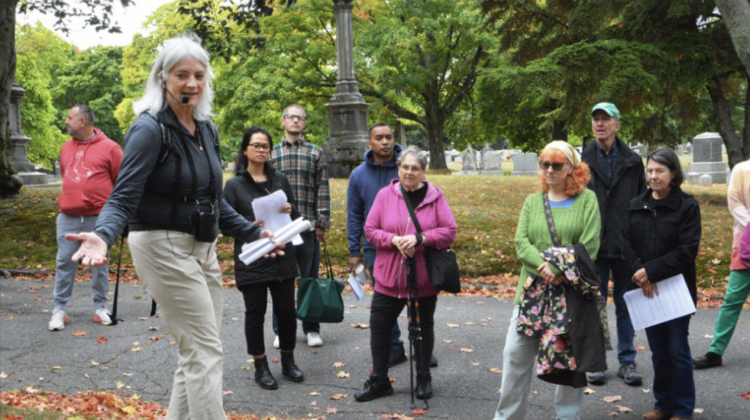LYNN — On the 162nd anniversary of the Emancipation Proclamation Sunday, community members took a walk around Pine Grove Cemetery to learn more about Lynners who played an important role in abolition.
The tour is part of a series of six tours hosted by the Pine Grove Cemetery Commission that explore the city’s history and recognize notable figures.
Upon walking the cemetery, one might recognize the names from some of the grave stones as street names of the historic downtown — in particular, Samuel Silsbee and James Buffum were highlighted as two of the city’s game shakers on the path to emancipation.
Julia Greene, a volunteer who led the tour, said she was excited to see so many people there because it is important for people to know that Lynn played a role in ending slavery.
National abolitionists including Frederick Douglass, William Lloyd Garrison, Abby Kelly, and the Hutchinson Family, all have history in Lynn as well.
William Lloyd Garrison, a leading abolitionist nationwide, created an Anti-Slavery Society in the city in 1833. Buffum quickly befriended Lloyd Garrison as they were both 25 years old at the time.
Referring to Buffum, Greene said he should be more of a well known name in the city.
Reading from an obituary she said was printed on the front page of The New York Times, the day after Buffum died, the obituary referred to Buffum as “one of the last of the band of abolitionists led by Garrison and Wendell Phillips.”
“When (Frederick) Douglass was dragged out of a car on the eastern railroads because of his color, Mr. Buffum heroically fought the mob,” Greene read. “He and Douglass went to England in 1845 to protest against the Free Church of Scotland, keeping the money contributed to it by the slaveholders of America.”
Buffum was elected twice mayor and elected state representative. Greene said Buffum was also the founder of the Free Church of Lynn.
Silsbee, who was born of Quaker parentage in 1798 died at 92 years old. In his early life, he was a lobsterman for Nahant. Greene said he was an agent of the underground railroad.
“He was always a strong anti-slavery man, and obeyed the higher law, rather than slave law,” Greene said.
She said when a hunted slave, George Latimer came to the city, Silsbee “secreted him” away in a bail of hay.
Latimer, a light-skinned Black man, first disguised himself as an old white to woman and pretended that his wife was his slave to try escaping.
James Gray, a slave owner, was offering a reward of $2,500 to anyone who would return Latimer. He was quickly recognized by a former employee of Gray and arrested.
“Latimer’s Arrest resulted in an uproar so great that Boston was, without a doubt, the most potentially violent city in America,” Greene said.
She said a newly created committee dedicated to freeing Latimer printed issues of The Latimer Journal every other day.
“The Latimer Journal reported that the social unrest related to Latimer’s imprisonment was such that fire and bloodshed threatened in every direction,” she said.
Ultimately, the unrest caused by Latimer’s arrest led to the two separate petitions being created.
One petition called for a law banning involvement of state officials or public property in the detention or arrest of suspected fugitives. The other would be sent to congress demanding laws be passed severing the connection between Massachusetts and slavery.
“The petition delivered to the state assembly contained 64,526 signatures, and weighed 150 pounds by the time it was delivered on February 7, 1843,” Greene said. This led to the passing of the Personal Liberty Act.
Latimer’s first born child was also born at Frederick Douglass’ home in Lynn.
Some other abolitionists who are buried in the Pine Grove Cemetery are Lydia Pinkham, who founded the Lynn Female Anti-Slavery Society, John Bassett Alley, a member of Congress from 1859-1867, who was a Free Soil Party member.

